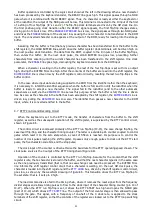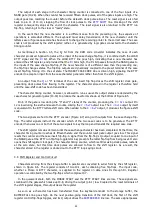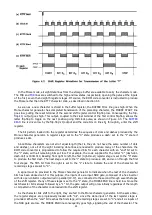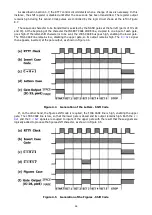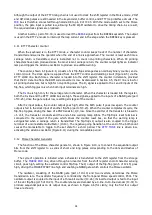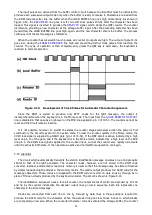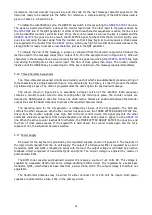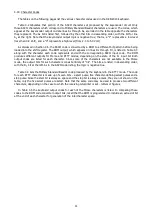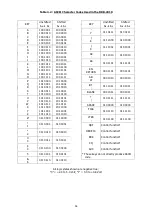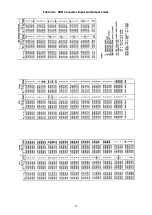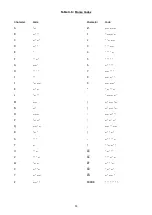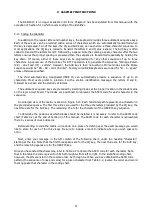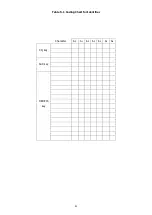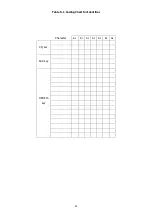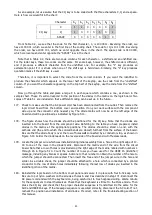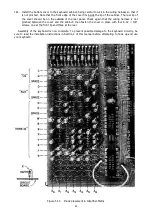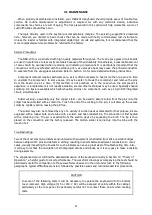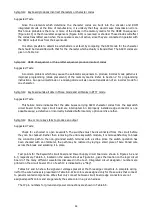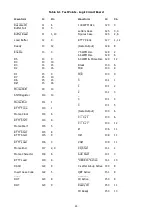
34
increments, the next decoder line goes low, and the code for the next message character appears on the
data lines ready to be loaded into the buffer. For reference, a complete listing of the ASCII codes used is
given in Table 4.2 in Section 4.18.
To initiate the identification cycle, the HERE IS keyswitch is closed, pulling the
HERE IS START
line low.
The signal is inverted and fed to a gate at the counter reset input. The other input to the gate is driven by
the
ID ACTIVE
line. If the QBF generator or either of the three-character sequencers is active, the line is low
and the identifier counters cannot be reset. If not, the counter resets as soon as the key is pressed and the
HERE IS ACTIVE
line goes low. As a result, the ID ACTIVE signal, fed back from the ID control circuitry, also
goes low, removing the reset signal from the counter, so that it may begin its count sequence. Clock pulses
are supplied to the counter from the
READY ID
line, which goes high for two HØ clock pulses whenever the
storage buffer is ready to accept a new character, just as in the QBF generator.
To indicate the end of the message, a jumper is connected from the decoder output which follows the
last line used for the message codes (the 3 output of IC-40 in the example shown in Figure 8.13). When all
characters in the message have been produced, this last line goes low, driving the
HERE IS ACTIVE
line high
and closing the NOR gate at the counter input. The flow of clock pulses then stops. The counter remains
inactive until the HERE IS key is pressed again. If the key is held down, the message repeats immediately.
4.16 Three-Character Sequencers
Two three-character sequencer circuits are provided, each of which can automatically produce a string of
three characters at a single keyswitch closure. One, activated by the CQ key, is coded to produce the letters
CQ followed by a space. The other is programmed at the user's option for any desired message.
The circuit, shown in Figure 8.14, is essentially a simpler version of the identifier. Each sequencer
contains a two-bit counter wired to stop counting after the third input pulse. The counter outputs are
decoded by NAND gates to drive the X lines of a diode matrix. Diodes are positioned between the decoder
output lines and the ASCII data lines to produce the required character codes.
The operating cycle for the CQ generator is initiated by closure of the CQ keyswitch. The AUX key
controls the other sequencer. When either counter has been reset, the THREE LETTER GROUP ACTIVE line,
driven from the counter outputs, goes high. Fed to the ID control circuit, this signal prevents the other
automatic character sequencers from being activated, and allows clock pulses to appear on the
READY ID
line. When the active counter reaches its fourth state, the THREE LETTER GROUP ACTIVE line goes low, and
the flow of clock pulses ceases. If the keyswitch is held closed, the counter resets again and the cycle
repeats. If not, the sequencer becomes inactive.
4.17 Power Supply
DC power for the keyboard is provided by two regulated supplies, shown in Figure 8.15. The majority of
the logic circuits operate from the +5 Volt supply. The output of a full-wave rectifier is regulated by a pair of
transistors, Q201 and Q202, connected in series with the load. The output voltage is controlled by an active
feedback circuit composed of transistors Q203 and Q204. The output voltage is adjusted by means of
potentiometer P201.
The ROM code converter and keyboard encoder IC's require a source of –12 Volts DC. This voltage is
supplied by a separate transformer and a voltage-doubling rectifier circuit. It is regulated by a series-pass
transistor, Q205, which drives its base bias from a zener diode, D203. The output voltage is therefore not
adjustable.
The transformer primaries may be wired for either nominal 115 or 230 Volt AC inputs. Both power
supplies are protected by a fuse, F301, in the primary circuit.
Summary of Contents for DKB-2010
Page 1: ......
Page 20: ...18...
Page 39: ...37 Table 4 3 ROM Converter Input and Output Codes...
Page 52: ...50 Figure 6 1 Logic Circuit Board Test Points...
Page 53: ...51 Figure 6 2 Keyswitch Circuit Board Test Points...
Page 54: ...52 Figure 6 3 Power Supply Circuit Board Test Points...
Page 57: ...55 Table 6 4 DKB 2010 Wire List...
Page 63: ...61...
Page 64: ...62...
Page 65: ...63...
Page 67: ...65...
Page 69: ...67...
Page 71: ...69...
Page 73: ...71...
Page 75: ...73...
Page 77: ...75...
Page 79: ...77...
Page 81: ...79...
Page 83: ...81...
Page 85: ...83...
Page 87: ...85...
Page 89: ...87...
Page 91: ...89...
Page 92: ...90...
Page 93: ...91...
Page 94: ...92...
Page 95: ...93...
Page 96: ...A1 EXTENDED MEMORY OPTION FOR THE DKB 2010 KEYBOARD INSTRUCTION MANUAL...
Page 100: ...A5...
Page 101: ...A6...


